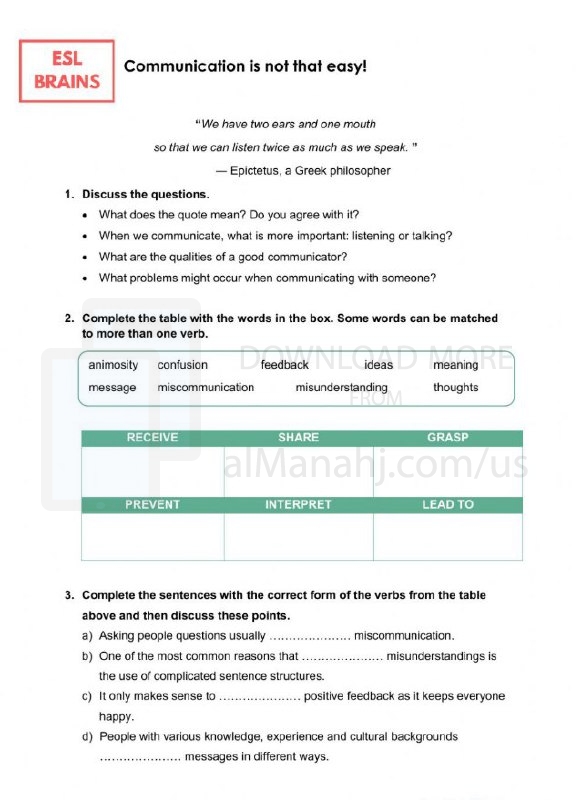| You are here: Almanahj Website ⇒ American curriculum ⇒ 12th Grade ⇒ Information and comm ⇒ Term 1 | ||
|---|---|---|
Worksheet about Communication is not that easy | ||
|---|---|---|
| Subject: Information and comm | ||
| 12th Grade | ||
| Term 1 | ||
| Year: 2023/2024 | ||
| Size: 633KB | ||
| Number of clicks: 149 | ||
| Publish date:November 16, 2023 | ||
| Added by: Eman | ||
| Last download date: 2024-09-13 07:46:40 | ||
| Updated by: Eman9966 on 2023-11-16 14:46:37 | By: theodor Imtheteacher | |
| File info: Communication is a fundamental aspect of human interaction, enabling us to exchange information, express emotions, and build relationships. While communication is an innate ability, it can be challenging, often requiring conscious effort, skill development, and continuous adaptation. Factors Contributing to Communication Difficulties: Language barriers: Differences in language can hinder effective communication, leading to misunderstandings and frustration. Cultural differences: Cultural norms and expectations can influence communication patterns, sometimes causing misinterpretations and clashes. Nonverbal cues: Nonverbal communication, such as body language, facial expressions, and tone of voice, can significantly impact the meaning conveyed, and misinterpretation of these cues can lead to communication breakdowns. Emotional barriers: Strong emotions, such as anger, anxiety, or fear, can cloud judgment and hinder clear communication. Personal biases and prejudices: Pre-existing biases and prejudices can color perceptions and influence the interpretation of messages. Communication apprehension: Fear of public speaking, social anxiety, or shyness can make communication a daunting task. Strategies for Effective Communication: Active listening: Engage fully in the communication process, paying attention to verbal and nonverbal cues, and asking clarifying questions. Empathy and understanding: Strive to understand the speaker's perspective, emotions, and motivations. Clear and concise language: Use appropriate language, avoiding jargon or ambiguity, and conveying thoughts in a straightforward manner. Nonverbal communication: Utilize nonverbal cues effectively, maintaining eye contact, using appropriate facial expressions, and adopting an open posture. Feedback and clarification: Provide feedback to ensure understanding, and seek clarification when unsure about the intended message. Respectful communication: Maintain a respectful tone, even when disagreeing, and avoid interrupting or dominating the conversation. Context awareness: Consider the context of the communication, tailoring the message to the specific situation and audience. Overcoming Communication Challenges: Embrace cultural differences: Learn about and appreciate different cultural norms and expectations to enhance cross-cultural communication. Be mindful of nonverbal cues: Pay attention to your own nonverbal communication and that of others, and be aware of the impact these cues have on the message. Manage emotions: Take steps to manage strong emotions before engaging in important conversations, and seek support if needed. Challenge biases and prejudices: Recognize and challenge your own biases and prejudices to promote open and unbiased communication. Practice and self-reflection: Practice communication skills regularly, and reflect on your interactions to identify areas for improvement. Seek professional help: If communication difficulties are significantly impacting your personal or professional life, consider seeking professional guidance from a therapist or communication specialist. Conclusion: Effective communication is a valuable skill that requires conscious effort, continuous learning, and adaptability. By understanding the challenges and employing effective strategies, we can enhance our communication abilities, foster stronger relationships, and navigate the complexities of human interaction. | ||
| Downloading link Worksheet about Communication is not that easy |
|---|
|
1700133875.pdf
The file is being prepared for download
|
| File images |
|---|
 |